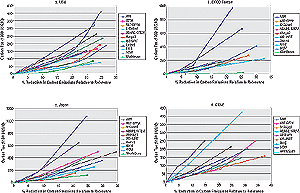8.2.2.1.1 Net Economic Costs under Lump-sum Recycling
The simplest way to simulate the recycling of a carbon tax or of auctioned
permits is through a lump-sum transfer. Such recycling does not correspond to
any likely policy in the real world. However, these modelling experiments provide
a useful benchmark to which other forms of recycling can be compared. In addition,
they allow an easy intercountry comparison of the impacts of emissions constraint
before the impacts of the many types of possible recycling policies are considered.
The comparative study carried out by the Energy Modeling Forum (EMF, Stanford
University) is very useful in this respect: EMF-16 (1999) examined the costs
of compliance with the Kyoto Protocol as calculated by more than a dozen modelling
teams in the USA, Australia, Japan, and Europe (Table 8.4).
Most of the models used are general equilibrium models. While not strictly comparable
to the marginal technical abatement costs reported in Section
8.2.1, the magnitude of the carbon tax used in these models is determined
again by the difference between the costs of marginal source of supply (including
conservation) with and without the target. As in the B-U models, this parameter
depends in turn on such factors as the size of the necessary emissions reductions,
assumptions about the cost and availability of carbon-based and carbon-free
technologies, the fossil fuel resource base, and short- and long-term price
elasticity. Also important is the choice of base year: a model that provides
3 years to adapt to a constraint beginning in 2010 shows higher marginal abatement
costs than one that provides 8 years.
|

Figure 8.4: Incremental cost (US$/tC) by regions.
|
Figures 8.4-a to 8.4-d
show the incremental cost of reducing a ton of carbon for alternative levels
of CO 2 reductions in the USA, OECD Europe, Japan, and Other OECD
countries (CANZ) when all reductions are made domestically. Note there are
two differences with the B-U studies:
- these numerical experiments do not consider negative cost abatement potentials
and presume that if an action is economically justifiable in its own right,
it will be undertaken independent of climate-related concerns; and
- because they incorporate demand elasticity and multiple macroeconomic feedback,
these marginal cost curves do not behave as those found in the B-U studies.
A first conclusion that could be drawn from Table 8.4
is that no strict correlations occur between the necessary carbon tax to reach
a certain emission target and the GDP loss faced by a country. While the carbon
tax in Japan is systematically higher than that for the USA, most studies conclude
lower GDP losses in Japan than in the USA. In general, the carbon taxes are
highest in OECD Europe and Japan, while the GDP losses are highest in the USA
and Other OECD countries. This absence of strict correlation between marginal
taxes and GDP losses is explained by the pre-existing energy supply, the structural
economic features, and the pre-existing fiscal system. For instance, if a country
relies more on renewable energy, and is specialized in low carbon-intensive
industry, the impact of a given level of carbon tax will be lower. However,
as the burden of emission reductions falls only on a few sectors, the carbon
tax for a given target will be higher.
| Table 8.4: Energy Modelling Forum Results: carbon
tax and GDP losses in 2010 with lump-sum recycling (in 1990 US$) |
 |
| |
Carbon tax in 2010
|
GDP losses in 2010 (%)
|
 |
| Model |
USA
|
OECD-E
|
Japan
|
CANZ
|
|
USA
|
OECD-E
|
Japan
|
CANZ
|
  |
| ABARE-GTEM |
322
|
665
|
645
|
425
|
|
1.96
|
0.94
|
0.72
|
1.96
|
| AIM |
153
|
198
|
234
|
147
|
|
0.45
|
0.31
|
0.25
|
0.59
|
| CETA |
168
|
|
|
|
|
1.93
|
|
|
|
| G-Cubed |
76
|
227
|
97
|
157
|
|
0.42
|
1.50
|
0.57
|
1.83
|
| GRAPE |
|
204
|
304
|
|
|
|
0.81
|
0.19
|
|
| MERGE3 |
264
|
218
|
500
|
250
|
|
1.06
|
0.99
|
0.80
|
2.02
|
| MIT-EPPA |
193
|
276
|
501
|
247
|
|
|
|
|
|
| MS-MRT |
236
|
179
|
402
|
213
|
|
1.88
|
0.63
|
1.20
|
1.83
|
| Oxford |
410
|
966
|
1074
|
|
|
1.78
|
2.08
|
1.88
|
|
| RICE |
132
|
159
|
251
|
145
|
|
0.94
|
0.55
|
0.78
|
0.96
|
| SGM |
188
|
407
|
357
|
201
|
|
|
|
|
|
| WorldScan |
85
|
20
|
122
|
46
|
|
|
|
|
|
 |
A second observation from this comparison is that the lump-sum recycling of
tax revenue never gives a strong double dividend, which is in accordance with
theory and is confirmed by country studies. This is the case in particular for
Denmark (Frandsen et al., 1995; Jensen, 1998; Gørtz et al.,
1999), France (Bernard and Vielle, 1999a), Finland (Jerkkola et al.,
1993; Nilsson, 1999), and Norway (Brendemoen and Vennemo, 1994; Johnsen et
al., 1996; Håkonsen and Mathiesen, 1997). These studies demonstrate
welfare losses of the same order of magnitude as those of global models, ranging
from 0.14% to 1.2% for various levels of emissions abatement ranging from 15%
to 25% over a 10-year time period. Only a very few studies conclude to some
strong form of double-dividend but do not explain the contradiction between
this result and lessons from analytical works.
|